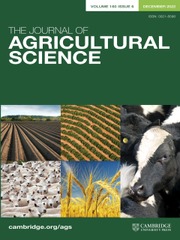Crossref Citations
This article has been cited by the following publications. This list is generated based on data provided by
Crossref.
Schoeman, S. J.
and
Visser, J. A.
1995.
Comparative water consumption and efficiency in three divergent sheep types.
The Journal of Agricultural Science,
Vol. 124,
Issue. 1,
p.
139.
Pagenstedt, Georg
1996.
Strategische Planung für Anbieter von Abonnementfernsehen.
p.
76.
Kyriakis, S. C.
2001.
Animal Models — Disorders of Eating Behaviour and Body Composition.
p.
205.
Cairns, M. C.
Cooper, J. J.
Davidson, H. P. B.
and
Mills, D. S.
2002.
Association in horses of orosensory characteristics of foods with their post-ingestive consequences.
Animal Science,
Vol. 75,
Issue. 2,
p.
257.
Thomas, Dean Timothy
Rintoul, Allan John
and
Masters, David Gordon
2007.
Sheep select combinations of high and low sodium chloride, energy and crude protein feed that improve their diet.
Applied Animal Behaviour Science,
Vol. 105,
Issue. 1-3,
p.
140.
Hill, J.
2007.
Impacts of nutritional technology on feeds offered to horses: A review of effects of processing on voluntary intake, digesta characteristics and feed utilisation.
Animal Feed Science and Technology,
Vol. 138,
Issue. 2,
p.
92.
Ashibe, Bunichiro
Hirai, Toshitake
Higashi, Kyoichiro
Sekimizu, Kazuhisa
and
Motojima, Kiyoto
2007.
Dual Subcellular Localization in the Endoplasmic Reticulum and Peroxisomes and a Vital Role in Protecting against Oxidative Stress of Fatty Aldehyde Dehydrogenase Are Achieved by Alternative Splicing.
Journal of Biological Chemistry,
Vol. 282,
Issue. 28,
p.
20763.
D'Eath, Richard B.
Tolkamp, Bert J.
Kyriazakis, Ilias
and
Lawrence, Alistair B.
2009.
‘Freedom from hunger’ and preventing obesity: the animal welfare implications of reducing food quantity or quality.
Animal Behaviour,
Vol. 77,
Issue. 2,
p.
275.
Ashibe, Bunichiro
Nakajima, Yu
Fukui, Yuka
and
Motojima, Kiyoto
2012.
PPARαas a Transcriptional Regulator for Detoxification of Plant Diet-Derived Unfavorable Compounds.
PPAR Research,
Vol. 2012,
Issue. ,
p.
1.
Dunn, Ian C.
Meddle, Simone L.
Wilson, Peter W.
Wardle, Chloe A.
Law, Andy S.
Bishop, Valerie R.
Hindar, Camilla
Robertson, Graeme W.
Burt, Dave W.
Ellison, Stephanie J. H.
Morrice, David M.
and
Hocking, Paul M.
2013.
Decreased expression of the satiety signal receptor CCKAR is responsible for increased growth and body weight during the domestication of chickens.
American Journal of Physiology-Endocrinology and Metabolism,
Vol. 304,
Issue. 9,
p.
E909.
Khan, Md. Sakirul Islam
Shigeoka, Chisa
Takahara, Yuriko
Matsuda, Seiji
and
Tachibana, Tetsuya
2015.
Ontogeny of the corticotrophin-releasing hormone system in slow- and fast-growing chicks (Gallus gallus).
Physiology & Behavior,
Vol. 151,
Issue. ,
p.
38.
Dong, Yang
Zhang, Xiaolei
Xie, Min
Arefnezhad, Babak
Wang, Zongji
Wang, Wenliang
Feng, Shaohong
Huang, Guodong
Guan, Rui
Shen, Wenjing
Bunch, Rowan
McCulloch, Russell
Li, Qiye
Li, Bo
Zhang, Guojie
Xu, Xun
Kijas, James W.
Salekdeh, Ghasem Hosseini
Wang, Wen
and
Jiang, Yu
2015.
Reference genome of wild goat (capra aegagrus) and sequencing of goat breeds provide insight into genic basis of goat domestication.
BMC Genomics,
Vol. 16,
Issue. 1,
Tuấn, Nguyễn Trí
Tuân, Nguyễn Trọng
and
Hằng, Vũ Thị
2016.
Nghiên cứu tính chất cấu trúc của que nano ZnO.
Can Tho University Journal of Science,
Vol. 42,
Issue. ,
p.
91.
Tolkamp, Bert J.
and
D’Eath, Rick B.
2016.
Nutrition and the Welfare of Farm Animals.
Vol. 16,
Issue. ,
p.
11.
Yuan, Ning
Sun, Lin
Du, Shuai
Ge, Gentu
Wang, Zhijun
Li, Yuyu
Bao, Jian
Zhao, Muqier
Si, Qiang
Hao, Junfeng
and
Jia, Yushan
2022.
Effects of Harvesting Period and Storage Duration on Volatile Organic Compounds and Nutritive Qualities of Alfalfa.
Agriculture,
Vol. 12,
Issue. 8,
p.
1115.
Yan, Yinan
Chi, Shaxuan
Liu, Guiqiong
Huang, Yongjie
Pan, Dongmei
and
Jiang, Xunping
2022.
The c.612A>G mutation of MC4R affects constitutive activity and signaling in domestic goats.
Animal Genetics,
Vol. 53,
Issue. 5,
p.
665.
te Pas, Marinus F.W.
Park, Woncheoul
Srikanth, Krishnamoorthy
Kumar, Himansu
Kemp, Steve
Kim, Jun-Mo
Lim, Dajeong
Madsen, Ole
van den Brand, Henry
and
Park, Jong-Eun
2023.
Transcriptome Profiling.
p.
333.
Wang, Shuangye
Chen, Zihao
Wang, Mengxin
Zhang, Meiwen
Zhang, Chen
Huang, Tian
Zhao, Yunlin
and
Xu, Zhenggang
2024.
The feeding preference and bite response between Microtus fortis and Broussonetia papyrifera.
Frontiers in Plant Science,
Vol. 15,
Issue. ,

